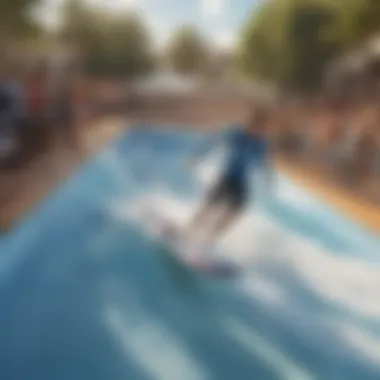Understanding Flowrider Pricing: Key Influencing Factors


Intro
Flowriders, those intriguing attractions offering a taste of surfing on land, are gaining traction in various recreational spots around the globe. Understanding their pricing dynamics is crucial for both buyers and enthusiasts alike. As we embark on this journey, we'll unpack the various elements that determine how much these thrilling water slides cost. Influences such as installation demands, regional factors, and brand reputation play pivotal roles in shaping the market landscape.
Whether you’re considering a purchase for a commercial venue or simply captivated by the flowriding phenomenon, grasping the nuances of their pricing can lead to informed decisions. Through this overview, we aim to paint a vivid picture of the factors at play in this niche market. Dive in, and let's start navigating these waves together.
Understanding Flowrider Installation Costs
Flowriders are not your average inflatable slide; they require careful consideration before installation. The setup itself involves significant capital, impacting overall pricing. Here’s a closer look at this aspect:
- Space Requirements: A typical flowrider demands ample square footage. Both indoor and outdoor setups come with their unique challenges, such as available space and climatic conditions.
- Site Preparation: This entails groundwork, plumbing, and electrical considerations. Often, the location's existing landscape introduces variable costs that a buyer may not initially account for.
- Water Management Systems: Maintaining optimal water flow and cleanliness often requires sophisticated pump systems. This includes everything from filtration to water heating, which can add to the initial expense.
Ultimately, the installation costs are the bedrock of the flowrider's pricing model, and understanding these intricacies helps prospective buyers assess potential return on investment.
Brand Influence on Flowrider Prices
In any market, brand reputation holds weight. With flowriders, this is especially prevalent. Brands like WaveLoch and SurfStream have developed a loyal following due to their reliability and innovation. Here's how brand factors into flowrider pricing:
- Quality Assurance: Established brands often guarantee superior materials and technology. Their products are tested rigorously, ensuring safety and longevity.
- Warranty and Support: Renowned brands commonly provide longer warranties and greater customer support, which can make a significant difference in cost over time.
- Resale Value: When you invest in a reputable brand, you’re likely to see a better resale value should you decide to part with your flowrider down the line.
Buying into a well-established brand may initially feel like a stretch on your wallet, but over time, the potential savings on maintenance and repairs could lead to a stronger investment.
Regional Availability and Its Impact on Prices
Region plays a critical role in determining flowrider prices. The demand for these attractions varies, often dictated by climate, tourism patterns, and regional preferences:
- Climate Considerations: Areas with year-round favorable weather increase foot traffic, leading to higher prices. For instance, coastal regions might see steep pricing because of continuous demand.
- Market Competition: In saturated markets where multiple vendors offer flowriders, prices could be more competitive. This aspect may lead to discounts or bundled services, lessening the initial investment burden.
- Local Regulations: Different regions have unique safety and installation regulations, which can influence costs. Buyers need to also consider these compliance expenses when budgeting for their flowrider.
Understanding these regional influences can help buyers manage expectations and make choices conducive to their specific environments.
Long-Term Ownership Costs
When contemplating a flowrider purchase, initial costs are only a piece of the puzzle. Long-term ownership comes with its own set of financial implications. Here are some considerations:
- Maintenance and Repairs: Regular upkeep is essential to ensure consistent performance. This includes inspections, cleaning, and potential repairs, all of which can add up.
- Utilities: Flowriders guzzle both water and electricity. One must factor these recurring costs into the operational budget.
- Insurance: As thrilling as flowriders can be, they may come with associated risks. Securing proper insurance is another cost that needs consideration.
A keen eye on these long-term costs helps potential buyers to prepare adequately and helps mitigate any unwelcome surprises along the way.
Foreword to Flowriders
Flowriders have emerged as a captivating blend of thrill and technical engineering, standing at the intersection of sport and leisure. These artificial wave generators have changed the way we think about surfing and water parks, providing opportunities for enthusiasts of all skill levels. They are hallmarks of modern recreation, offering a taste of surfing without the unpredictability of ocean waves. In this section, we’ll unpack the foundational elements of flowriders, expounding on their significance in today’s recreational landscape.
Definition and Functionality
At its core, a flowrider is a simulation of a surfing environment, often found in water parks, resorts, and recreational centers. These machines create controlled waves, allowing users to ride in a standing position or on a body board. The mechanics involve a powerful water jet system that propels water over a specially designed surface at high speeds, achieving a smooth, rideable surface. This technology is not just about gliding on water; it combines physics and mechanical engineering. The flow of water beneath the rider creates a dynamic surface that mimics the experience of actual surfing, giving even novices a sense of accomplishment as they learn to balance and maneuver.
Moreover, the flowrider setup is an inviting option for locations due to its compact footprint. Unlike traditional surfing, which requires an ocean and a waiting game for favorable waves, flowriders provide an instant fun experience. Users can enjoy short bursts of thrill, making it an attractive choice for places catering to both families and serious surfers. To put it succinctly, flowriders allow water sports enthusiasts to experience a semblance of surf culture, regardless of their inherent surfing capabilities or local geography.
Types of Flowriders Available
The market offers various types of flowriders tailored to meet different preferences and operational needs. Here’s a breakdown of some popular types:
- FlowRider Double: Designed for side-by-side riding, perfect for competitive showdowns or social gatherings. Two users can ride simultaneously, enhancing the fun and social interaction.
- FlowRider Single: A more compact option focused primarily on individual use. This model caters to those who want to practice their skills in a solo environment, often found in smaller venues.
- FlowRider Surf: This version includes wave configurations suitable for more advanced users. It offers variable wave types to enhance training or recreational experience, pushing users to perfect their surf techniques.
With such diversity in models, locations can better curate their offerings to appeal to their specific audiences, whether they are family-oriented parks or dedicated surf training facilities.
"Taking to the flowrider is not just about catching waves; it’s an experience that fosters camaraderie, skill, and a unique connection to water sports."
In summary, understanding the basics of flowriders arms potential buyers with critical knowledge, paving the way for informed decision-making. This foundational comprehension ties directly into the overall dynamics of pricing, installation, and other essential aspects explored further in this article.
Market Overview of Flowriders
Understanding the market for flowriders is essential for anyone considering a purchase or investment in these unique water attractions. As various locations, including theme parks, water sports facilities, and resorts, seek to attract a diverse audience, the demand for flowriders continues to grow. This section will explore market dynamics, highlight global trends, and introduce key players in the industry. By gaining insights into these elements, potential buyers can better strategize their purchasing decisions, ensuring they get the most bang for their buck.
Global Market Trends


The flowrider market has seen significant evolution over the last few years. One key trend is the increasing popularity of water parks and leisure facilities that feature flowriders, particularly in regions with warmer climates. Countries like the United States, Australia, and parts of Europe report rising foot traffic to these venues, translating into heightened demand for flowriders.
- Increased Accessibility: More venues are investing in flowriding experiences to diversify their offerings and capture both tourists and locals. This trend has made flowriders more accessible, thus boosting their visibility in the entertainment market.
- Technological Advances: Innovations in mechanical design have made newer models more efficient and user-friendly. Such advancements not only attract customers but also help improve the overall experience, positively impacting marketing strategies and potential sales.
- Sustainability Initiatives: As public consciousness regarding environmental impact grows, manufacturers are increasingly focusing on eco-friendly practices. This includes the use of recycled materials in construction and optimizing water usage.
The market's growth trajectory indicates a strong future for flowriders, aligning with several lifestyle trends that emphasize active living and recreational fun.
Key Manufacturers and Brands
Several brands stand out in the flowrider manufacturing scene, each bringing unique innovations to the table. A few notable names include:
- WaveLoch: Known for their reliable direct drive systems, WaveLoch has established a reputation for durability and performance.
- FlowRider: Perhaps the most recognized name, they offer a variety of models suited for different venues, from small attractions to large theme parks.
- Aquatic Development Group (ADG): This brand specializes in custom solutions, allowing facilities to tailor their flowriders to specific themes or environments.
These manufacturers constantly compete for market share by embracing new technologies and improving their product offerings. Understanding who the key players are affords buyers insight into the kind of support, warranty, and service options available post-purchase.
"Investing in a flowrider is not just about the current product's specs, but also the reputation of the company behind it."
Exploring the distinctions and reputations of these manufacturers gives buyers an upper hand when navigating through the options available in the market. Buyers should remember the importance of selecting a brand that not only meets their budget but also aligns with their long-term goals for sustainability and maintenance efficiency.
Understanding Flowrider Pricing
Understanding the pricing landscape of flowriders is more than just a matter of dollars and cents. It reveals vital insights into the factors that influence not just initial purchase costs but ongoing operational expenses as well. This overview helps prospective buyers appreciate the intricate web of elements that contribute to the financial decisions they must make. Acknowledging these nuances ensures that each investment is favorable and poised for long-term value.
When discussing flowrider pricing, it's paramount to consider various pieces of the financial puzzle:
- Base costs are the starting point. This includes the price of the unit itself, which can vary significantly based on the type and features.
- Influential factors like installation complexities, brand reputation, and market trends also weigh heavily on final prices. Each influences the decision-making process for buyers, whether they're an individual looking to add a flowrider to their property or a company seeking to attract customers through recreational offerings.
Moreover, the potential return on investment (ROI) can be compelling, particularly for businesses. Flowriders can contribute substantially to revenue through increased foot traffic, unique offerings, and even hosting events. These considerations are crucial for anyone contemplating a purchase.
"Investing in a flowrider isn’t just about the fun it brings – it's about understanding how it fits into the bigger financial picture."
Base Cost Considerations
When evaluating the pricing of flowriders, the base cost acts as the initial monetary barrier to entry. This encompasses the core unit price itself, which often varies widely, reflecting factors such as:
- Type and Size: Different configurations, from smaller, simpler models to large, complex systems, come with distinct price tags. Generally, larger units that cater to more users can lead to higher costs.
- Material Quality: The chosen materials can also play a big role in price. High-quality, durable components may incur a premium but can translate to lower long-term costs through reduced maintenance needs.
- Brand Reputation: Well-known brands like FlowRider and SurfLoft tend to charge more, but they may offer superior lifespans and warranties.
Each of these factors builds toward a base price that varies significantly from one flowrider to another, affecting prospective buyers' budget planning.
Influential Factors on Price
Beyond the base cost, several influential factors can contribute to fluctuations in flowrider pricing. Understanding these can empower buyers to negotiate better deals and anticipate future expenses. Here are some key considerations:
- Installation Complexity: The cost associated with setting up a flowrider can swing dramatically based on site preparation and structural requirements.
- Location and Regional Market: Prices might vary depending on geographic factors, including shipping costs, local regulations, and regional demand. For instance, coastal areas may see higher prices due to increased interest in water sports.
- Seasonal Trends: Demand can ebb and flow throughout the year, leading to price adjustments. For example, buyers may find better prices during the off-peak months when sellers are eager to clear their inventory.
- Technological Innovations: Advances in flowrider technology, especially those incorporating eco-friendly features, may also push prices higher. Buyers focused on sustainability might find such investments worth the initial cost due to their long-term savings and societal value.
Understanding these factors surrounding flowrider pricing can significantly aid buyers in making decisions that align strategically with their financial and operational goals.
Installation and Setup Costs
Understanding installation and setup costs is crucial when considering a flowrider. These expenses extend beyond the purchase price and can significantly affect your budget. Adequate planning is essential, as these costs can vary widely based on several factors, such as location, site conditions, and technical requirements.
Site Preparation Requirements
The first step in installing a flowrider is site preparation. This involves evaluating the area where the flowrider is to be set up. Key factors include:
- Space Availability: A minimum area is required to accommodate the play area and equipment.
- Ground and Soil Stability: The site must be assessed for stability. Loose or sandy soil may necessitate additional work to create a solid foundation.
- Water Source Access: Flowriders require a consistent water supply. Ensuring proximity to plumbing is vital.
Before installation, you’ll need to ensure the site meets local zoning and safety regulations. This might involve acquiring permits which can add to your overall expenses. It’s critical to engage professionals who know local requirements, so you don't face unexpected hitches down the line.
Labor and Technical Expertise
The labor and technical expertise involved in the installation process can't be underestimated. Hiring skilled professionals is essential for a successful setup. Consider the following:
- Specialized Contractors: Flowriders often need specific contractors with experience in aquatic installations. Their knowledge can help avoid costly mistakes.
- Technical Skills for Setup: Expertise in plumbing, electrical work, and mechanical setup is crucial. These elements are intertwined with the overall functionality of the flowrider.
- Timeline and Labor Costs: Installation complexity can extend the project timeline. Longer projects may mean higher labor costs, so factor in potential overtime fees.
"Successful installation entails meticulous planning and quality execution."
Ultimately, when you factor in installation and setup costs into your overall purchasing plan, it enables better budget management and ensures a smoother transition into flowrider ownership.


Operational Costs of Flowriders
When discussing flowriders, one cannot overlook the operational costs associated with them. Understanding these costs is vital for anyone thinking about acquiring one of these wave-generating marvels, whether for commercial use at a water park or for personal enjoyment in a backyard setting. The financial implications extend beyond the initial purchase price, unfolding into various ongoing expenses that can dramatically influence profitability and overall satisfaction.
Water and energy consumption represent a significant chunk of these operational costs. This aspect is critical in evaluating the long-term financial commitment of owning a flowrider. The importance of adequate infrastructure - particularly in terms of a reliable energy supply and a sufficient water source - cannot be understated. Additionally, one must consider maintenance and repairs that will arise over time, which could potentially deter potential buyers unless they budget wisely for these eventualities.
Investing in a flowrider is indeed a venture that involves more than just the upfront cost. If potential buyers grasp these ongoing expenses, they can make informed decisions that align with their budgets and intended usage. It’s an in-depth journey that needs analysis to weigh whether the riveting joy of surfing on artificial waves justifies the long-term financial obligations.
Water and Energy Consumption
When it comes to water and energy consumption, flowriders require a considerable amount of both to operate effectively. Water acts as the lifeblood of a flowrider, generating the waves that excite its users. Generally, a flowrider needs a continuous flow of water to create that perfect wave. The volume of water circulated can fluctuate based on the model and the specific design of the system.
- Water Usage: An average flowrider might use thousands of gallons of water per hour, depending on its size and operational speed. Given this substantial demand, owning a flowrider necessitates ensuring a reliable supply of water, be it from municipal sources or borewells.
- Energy Consumption: Energy consumption is another area worth scrutinizing. High-capacity pumps and specialized equipment ensure that the water is not only pushed to the top but also maintained at optimal temperatures. Most modern systems come equipped with energy-efficient technologies, yet owners should remain aware that operating these machines round-the-clock let's say in peak summer months, can lead to high electricity bills.
Properly assessing the ongoing water and energy costs is crucial for business operators who aim to maximize operational efficiency while ensuring customer satisfaction.
Maintenance and Repairs
Just like any piece of equipment that sees regular use, flowriders need routine maintenance and occasional repairs. It's not uncommon for wear and tear to set in much faster due to the nature of the product's mechanical and hydraulic systems. Therefore, it is essential to plan for these eventualities.
- Regular Maintenance: Regular cleaning of parts to prevent debris buildup keeps the system running smoothly. Annual inspections of pumps, water lines, and electrical components can help reveal any weaknesses before they lead to more intensive damage. Investing in a solid maintenance contract can spare a lot of headaches down the line.
- Repair Costs: In the unfortunate event a significant component fails, it's necessary to budget for repairs that could be costly. Parts such as pumps or control systems can be expensive, and replacement costs can vary widely. The condition of the flowrider, its age, and brand can impact these repair costs significantly.
Consequently, while the thrill of surfing might grab headlines, the behind-the-scenes efforts required to keep a flowrider in top shape often remain obscured. On the surface, it may seem negligible, but overlooking these operational costs could easily drive a potential buyer to the poorhouse.
"Purchasing a flowrider is more than just a thrilling investment; it involves understanding the mechanics behind its operation and preparing for costs that lie ahead."
In summary, while operational costs might feel like a heavy stone in one's pocket at first glance, with diligent planning and foresight, these expenses can be navigated effectively. Buyers should take into account these critical factors when considering their options in the flowrider market.
Comparative Pricing Analysis
Understanding the comparative pricing analysis of flowriders is essential for stakeholders who want to get a handle on market dynamics. Pricing isn’t just a number; it carries insights into various underlying factors that influence the costs, like region, demand, and the overall economic climate. Delving into this analysis helps potential buyers and suppliers see the broader picture, enabling better decisions tailored to their specific needs.
Regional Pricing Variations
One can't stress enough how much regional variations impact the price of flowriders. Consider this: prices vary significantly from coastal areas to inland regions. In coastal locations where water sports thrive, the demand for flowriders tends to be higher, inflating the prices due to the enthusiasm of beachgoers. Conversely, in places where surfing and similar activities are not part of the culture, prices can take a nosedive.
Some key factors behind regional pricing include:
- Local Competition: An area rife with outdoor sports facilities might see lower prices due to competition.
- Transportation Costs: The expense of shipping flowriders to more remote locations can hike up the final retail price.
- Economic Conditions of the Area: Regions with higher disposable income can sustain higher prices compared to economically struggling areas.
Adapting to these variances means buyers must conduct a ground survey before making a financial leap. It’s worth noting that for some buyers, investing in a flowrider that hails from away may still be appealing due to brand reputation, which can also tip the scales on pricing.
Second-Hand Market Influences
The second-hand market for flowriders introduces a different layer of complexity into pricing analysis. This market serves not just thrifty buyers, but also those looking to upgrade or seeking unique models that might no longer be in production. However, navigating this realm comes with its own set of challenges and opportunities.
When considering the second-hand market, factors to ponder include:
- Condition of the Equipment: A well-maintained flowrider can fetch a higher price, but one with wear and tear could be a gamble.
- Availability of Parts: Older models may have parts that are hard to source, pushing buyers to consider newer alternatives.
- Depreciation Trends: Typically, flowriders depreciate in value like cars. Knowing how quickly a model loses value can help buyers decide how to invest.
Moreover, browsing platforms like reddit.com can yield valuable insights and even offers unmatched deals from individual sellers keen on unloading their gear.
“Shopping in the second-hand market can either save you a pretty penny or leave you stuck with a lemon.”
Potential Financial Benefits and ROI
In today's competitive market, understanding the potential financial benefits and return on investment (ROI) of a flowrider installation is crucial. For many businesses and recreational facilities, a flowrider isn't just a leisure activity; it can serve as a substantial revenue-generating asset. The right approach can turn waves into profits, if one plays their cards right. With the growing popularity of surfing and water parks, the installation of flowriders can significantly enhance visitor attraction, leading to increased foot traffic and, consequently, higher earnings.
Revenue Generation Opportunities
Flowriders offer various avenues for generating revenue. First and foremost, they can become a primary attraction at water parks or leisure centers. By installing a flowrider, businesses tap into a niche that appeals to both surfers and thrill-seekers alike.
Some revenue streams include:
- Direct User Fees: Charging entry or session fees for individuals wanting to ride. This could be structured as a pay-per-ride or an hourly rate, providing flexibility for patrons.
- Membership Programs: Offering subscriptions or packages can create a loyal user base. Members can enjoy unlimited access while ensuring consistent cash flow for the facility.
- Special Events: Organizing competitions, training camps, or even parties can draw substantial crowds. These events can charge participants and spectators alike, generating a buzz in the community.
- Merchandising: Selling branded items such as apparel or accessories linked to the flowrider experience can add another layer of income.
By utilizing these methods, flowriders can transform from mere installations to integral components of an entire business model, ensuring that every wave brings in opportunities to cash in.


Community and Social Benefits
Beyond financial aspects, flowriders contribute positively to the social fabric of communities. These installations foster a sense of community engagement and encourage healthy lifestyles. Here are a few ways flowriders benefit local environments:
- Promoting Active Lifestyles: Encouraging individuals to replace sedentary behaviors with active fun promotes physical health. Surfers, swimmers, and onlookers experience excitement and adrenaline, drawing them towards more fitness-oriented activities.
- Cohesion and Inclusivity: Flowriders can serve as social hubs where diverse groups come together. Families, friends, and even complete strangers can bond over shared experiences, breaking down social barriers and fostering friendships.
- Youth Engagement Programs: Schools and community organizations can use flowriders for educational programs. Training young surfers not only teaches valuable skills but can also keep them engaged in positive activities, diverting them from less favorable pursuits.
Ultimately, when a flowrider is part of the mix, it doesn’t just yield financial gains but also enriches community life. The wave of benefits extends beyond money; it creates a ripple effect of positivity that resonates deeply within the societal context. It’s this blend of financial savvy and community involvement that makes investing in flowriders a wise decision for many.
Factors Influencing Purchase Decisions
Understanding the factors that influence purchase decisions for flowriders can greatly enhance the likelihood of a successful investment. This section dives into how various elements such as buyer demographics and usage scenarios affect the decision-making process. Grasping these factors not only aids vendors in tailoring their sales strategies but also enables potential buyers to make more informed choices based on their unique situations.
Buyer Demographics
Demographics play a crucial role in the flowrider market. Knowing who is likely to buy can make or break a sale. For instance, families may lean towards purchasing flowriders for recreational purposes at home, while commercial entities, such as gyms or water parks, might look at them as a means to boost visitor numbers.
Several demographic factors to consider include:
- Age Range: Younger audiences, particularly teenagers, typically show a greater interest in trendy water sports activities.
- Income Levels: Higher income households might be more inclined to invest in luxury items like a flowrider. Individuals with more disposable income often prioritize experiences over products.
- Location: Coastal regions or areas near recreational water bodies have a stronger buyer presence. Here, the culture surrounding water sports can push demand quite a bit.
Overall, recognizing these demographics can help sellers create targeted marketing campaigns, focusing on the specific needs and desires of different buyer segments. Additionally, understanding who the buyers are can lead to tailored product features that cater specifically to their interests.
Usage Scenarios and Environments
When it comes to actual usage scenarios, the environment where a flowrider will be installed and used can significantly impact purchasing decisions. The three primary usage contexts worth noting are residential, commercial, and recreational.
- Residential Use: For homeowners, the size of their outdoor area and local regulations regarding installations can steer their decisions. Those living in suburban or rural areas may have more freedom and space for a unit, while urban residents might be limited.
- Commercial Use: Businesses in the hospitality or entertainment sectors often aim to maximize customer experience. For them, flowriders can be an attractive investment that sets them apart from competitors. They might look for features like high-capacity units or increased durability, as these factors correlate with high foot traffic and extended usage.
- Recreational Settings: Locations like water parks or sports clubs require robust and resilient options. Here, the environment plays a pivotal role: units must endure constant use and weather conditions, requiring specific design features and materials to ensure longevity.
Ultimately, these scenarios inform potential buyers about what type of flowrider might best suit their lifestyle or business goals.
In essence, a thorough understanding of demographic factors and usage situations allows for a well-rounded approach to the buying process. This enables vendors to better meet the needs of diverse customers, facilitating smoother transactions and more satisfying experiences. By dissecting the motivations behind each buyer's decision, the entire market can move toward a more personalized and effective sales strategy.
Future Trends in Flowrider Technology
The landscape of Flowrider technology is perpetually evolving. As innovations come to the fore, the dynamics of pricing and operational efficiency are also changing. This evolving landscape is crucial for both buyers and manufacturers alike, as it informs them of what to expect in the coming years. Understanding these future trends helps in making prudent investment decisions, ensuring that stakeholders can stay ahead of the curve. It’s not just about the thrill of surfing anymore; it’s about how to maximize enjoyment while minimizing costs, and this is where upcoming advancements play a significant role.
Innovative Design Developments
When we talk about innovative design developments in flowriders, we’re delving into a treasure trove of possibilities. Recent trends show a shift towards more compact and versatile designs. For example, some companies are experimenting with adjustable wave heights, which allows the riders to tweak the ride intensity based on their skill levels. This innovation not only enhances user experience but also increases the range of potential customers from total novices to seasoned experts.
Additionally, tech integrations such as app-controlled settings are becoming more commonplace. Such features enable operators to monitor performance and make adjustments in real-time, which can lead to better safety measures and enjoyment. Imagine having the ability to alter the wave while your guests are riding—it’s certainly a game changer!
Furthermore, modular designs are receiving attention. These allow for easier upgrades and expansions without completely overhauling existing installations. A more modular approach means that owners can adapt their Flowrider setups without incurring substantial costs, thus combating some of the typical barriers to entry in maintaining these attractions.
Sustainability and Eco-Friendly Solutions
As the world becomes more conscious of environmental issues, sustainability in flowrider technology is rising to the forefront. Recent developments are largely focused on reducing water usage and energy consumption. By utilizing recirculating systems that decrease water waste, manufacturers are addressing one of the biggest ecological concerns associated with these machines.
One exciting trend is the implementation of solar panels to power systems or heating the water. This way, operators can significantly cut electrical costs, appealing to environmentally conscious consumers. Additionally, there is a move towards biodegradable materials in components, which could reduce the ecological footprint of flowriders in the long run.
Moreover, the focus on eco-friendly solutions plays a vital role in aligning brands with the growing green consumer movement. Purchasing and promoting sustainable flowriders can not only be a selling point but can also foster a community that values ecological stewardship.
"Sustainability isn't just a trend; it's becoming a standard expectation throughout various industries including entertainment."
These trends in technological advancements and sustainable practices point to a future where the enjoyment of water sports aligns with responsible environmental stewardship. As these innovations develop, they stand to redefine the attractiveness and pricing structure of flowriders, ultimately influencing the purchasing decisions of many.
Ending
In wrapping up the discussion on Flowriders, it’s crucial to reflect on the multifaceted nature of their pricing dynamics. The affordability and value proposition surrounding Flowriders aren't just dictated by their initial purchase price; various elements, such as installation costs, maintenance expenses, and the potential for revenue generation, play an integral role. Additionally, the trends in technology and shifts in consumer preferences will impact the pricing landscape.
Summarizing Key Insights
- Installation Complexity: The setup of a Flowrider can range from straightforward to highly technical, directly influencing the total cost. For example, complex site preparations in urban locations can easily bump up expenses.
- Ongoing Operational Costs: Regular maintenance, water supply, and energy consumption can accumulate over time. Buyers must factor these into their long-term budgets to avoid unexpected financial burdens.
- Market Variability: Prices can fluctuate dramatically across different regions, which means local market conditions, competition, and demographic factors play a significant role in determining final costs.
- Second-Hand Opportunities: The second-hand market often offers significant savings for savvy buyers, but caution is key as quality and lifespan can vary.
These insights are vital not just for potential buyers within the surfing community but also for businesses aiming to incorporate Flowriders into their recreational offerings. They illuminate the complexities behind pricing which, if overlooked, could lead to misguided investments.
Looking Ahead in the Market
As we peer into the future of Flowriders and their pricing, a few trends are worth noting:
- Technological Advancements: Continuous improvements in design and energy efficiency might lead to lower operational costs, making Flowriders more attractive to a wider audience. Potential buyers should keep an ear to the ground for emerging innovations that may disrupt current pricing models.
- Sustainability Focus: As eco-consciousness grows among consumers, Flowriders that integrate sustainable practices may see an uptick in demand. This shift could reshape pricing strategies, catapulting eco-friendly gear to a premium position in the market.
- Diverse User Adoption: Beyond the surfing community, Flowriders are gaining traction at resorts, water parks, and fitness centers. As diverse markets adopt these installations, prices could stabilize or even decrease due to increased competition.
Understanding these potential shifts will equip buyers with foresight to navigate the ever-evolving market landscape with confidence. Further exploration into these elements will empower consumers to make informed decisions whether they’re looking to install one or simply enjoying the ride at their favorite beach.















